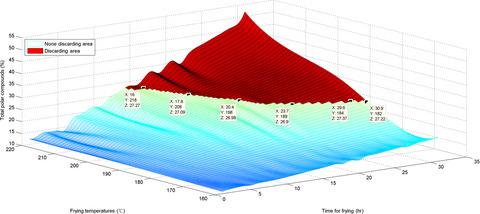当前位置:
X-MOL 学术
›
Food Sci. Nutr.
›
论文详情
Our official English website, www.x-mol.net, welcomes your feedback! (Note: you will need to create a separate account there.)
Physicochemical parameter based estimation of discarding points for frying oil using data interpolation and principal component transformation.
Food Science & Nutrition ( IF 3.9 ) Pub Date : 2020-04-02 , DOI: 10.1002/fsn3.1524 Yumei Li 1 , Xianbing Cao 1 , Yanping Cao 2, 3 , Yuxu Feng 1 , Jingjun Ji 2, 3 , Jiuying Xie 2, 3 , Xin Wang 1
Food Science & Nutrition ( IF 3.9 ) Pub Date : 2020-04-02 , DOI: 10.1002/fsn3.1524 Yumei Li 1 , Xianbing Cao 1 , Yanping Cao 2, 3 , Yuxu Feng 1 , Jingjun Ji 2, 3 , Jiuying Xie 2, 3 , Xin Wang 1
Affiliation

|
Data interpolation and principal component transformation (PCT) were used to compute the discarding points of a frying oil by measuring the physicochemical parameters—acid value, carbonyl value, and total polar compounds. Herein, the discarding point refers to the time point (associated with the value of each physicochemical parameter) at which the frying oil should be discarded. First, a primary visual analysis was performed for the obtained data by using line charts. Second, a curve interpolation method was used to compute the discarding points for each parameter and thus determine the discarding points for the frying oil. At 190, 205, and 220°C, the frying oil reached the discarding points at 22.1, 17.7, and 13 hr, respectively. The discarding area was also visualized on the corresponding surfaces for the originally obtained data and the interpolated data to investigate the discarding points. Third, the PCT was conducted for the three parameters at each temperature; the discarding point estimation for the three parameters could be reduced to the estimation from the first principal component (FPC), thereby simplifying this process. At 190, 205, and 220°C, the frying oil reached the discarding points when the FPCs were 10.4524, 6.2881, and −1.7629 at the time points 22.1, 17.7, and 13 hr, respectively. Finally, a verification experiment revealed that the correlation between the results obtained by our interpolation method or PCT and the verified data was higher than 0.98, which demonstrates the effectiveness of our method.
中文翻译:

使用数据插值和主成分变换,基于理化参数的煎炸油废弃点估计。
通过测量理化参数(酸值,羰基值和总极性化合物),使用数据插值和主成分变换(PCT)来计算煎炸油的丢弃点。在此,废弃点是指应废弃油炸油的时间点(与各理化参数的值相关)。首先,使用折线图对获得的数据进行初步的视觉分析。其次,使用曲线插值法计算每个参数的丢弃点,从而确定煎炸油的丢弃点。在190、205和220°C下,煎炸油分别在22.1、17.7和13 hr到达丢弃点。还针对原始获得的数据和插值数据在相应的表面上可视化了丢弃区域,以研究丢弃点。第三,在每个温度下对三个参数进行PCT。可以将这三个参数的丢弃点估计简化为根据第一主成分(FPC)进行的估计,从而简化了此过程。在190、205和220°C时,当FPC分别为22.1、17.7和13 hr时的FPC为10.4524、6.2881和-1.7629时,煎炸油达到了丢弃点。最后,验证实验表明,我们的插值方法或PCT获得的结果与验证数据之间的相关性高于0.98,这证明了我们方法的有效性。第三,在每个温度下对三个参数进行PCT。可以将这三个参数的丢弃点估计简化为根据第一主成分(FPC)进行的估计,从而简化了此过程。在190、205和220°C时,当FPC分别为22.1、17.7和13 hr时的FPC为10.4524、6.2881和-1.7629时,煎炸油达到了丢弃点。最后,验证实验表明,我们的插值方法或PCT获得的结果与验证数据之间的相关性高于0.98,这证明了我们方法的有效性。第三,在每个温度下对三个参数进行PCT。可以将这三个参数的丢弃点估计简化为根据第一主成分(FPC)进行的估计,从而简化了此过程。在190、205和220°C时,当FPC分别为22.1、17.7和13 hr时的FPC为10.4524、6.2881和-1.7629时,煎炸油达到了丢弃点。最后,验证实验表明,我们的插值方法或PCT获得的结果与验证数据之间的相关性高于0.98,这证明了我们方法的有效性。从而简化了此过程。在190、205和220°C时,当FPC分别为22.1、17.7和13 hr时的FPC为10.4524、6.2881和-1.7629时,煎炸油达到了丢弃点。最后,验证实验表明,我们的插值方法或PCT获得的结果与验证数据之间的相关性高于0.98,这证明了我们方法的有效性。从而简化了此过程。在190、205和220°C时,当FPC分别为22.1、17.7和13 hr时的FPC为10.4524、6.2881和-1.7629时,煎炸油达到了丢弃点。最后,验证实验表明,我们的插值方法或PCT获得的结果与验证数据之间的相关性高于0.98,这证明了我们方法的有效性。
更新日期:2020-04-02
中文翻译:

使用数据插值和主成分变换,基于理化参数的煎炸油废弃点估计。
通过测量理化参数(酸值,羰基值和总极性化合物),使用数据插值和主成分变换(PCT)来计算煎炸油的丢弃点。在此,废弃点是指应废弃油炸油的时间点(与各理化参数的值相关)。首先,使用折线图对获得的数据进行初步的视觉分析。其次,使用曲线插值法计算每个参数的丢弃点,从而确定煎炸油的丢弃点。在190、205和220°C下,煎炸油分别在22.1、17.7和13 hr到达丢弃点。还针对原始获得的数据和插值数据在相应的表面上可视化了丢弃区域,以研究丢弃点。第三,在每个温度下对三个参数进行PCT。可以将这三个参数的丢弃点估计简化为根据第一主成分(FPC)进行的估计,从而简化了此过程。在190、205和220°C时,当FPC分别为22.1、17.7和13 hr时的FPC为10.4524、6.2881和-1.7629时,煎炸油达到了丢弃点。最后,验证实验表明,我们的插值方法或PCT获得的结果与验证数据之间的相关性高于0.98,这证明了我们方法的有效性。第三,在每个温度下对三个参数进行PCT。可以将这三个参数的丢弃点估计简化为根据第一主成分(FPC)进行的估计,从而简化了此过程。在190、205和220°C时,当FPC分别为22.1、17.7和13 hr时的FPC为10.4524、6.2881和-1.7629时,煎炸油达到了丢弃点。最后,验证实验表明,我们的插值方法或PCT获得的结果与验证数据之间的相关性高于0.98,这证明了我们方法的有效性。第三,在每个温度下对三个参数进行PCT。可以将这三个参数的丢弃点估计简化为根据第一主成分(FPC)进行的估计,从而简化了此过程。在190、205和220°C时,当FPC分别为22.1、17.7和13 hr时的FPC为10.4524、6.2881和-1.7629时,煎炸油达到了丢弃点。最后,验证实验表明,我们的插值方法或PCT获得的结果与验证数据之间的相关性高于0.98,这证明了我们方法的有效性。从而简化了此过程。在190、205和220°C时,当FPC分别为22.1、17.7和13 hr时的FPC为10.4524、6.2881和-1.7629时,煎炸油达到了丢弃点。最后,验证实验表明,我们的插值方法或PCT获得的结果与验证数据之间的相关性高于0.98,这证明了我们方法的有效性。从而简化了此过程。在190、205和220°C时,当FPC分别为22.1、17.7和13 hr时的FPC为10.4524、6.2881和-1.7629时,煎炸油达到了丢弃点。最后,验证实验表明,我们的插值方法或PCT获得的结果与验证数据之间的相关性高于0.98,这证明了我们方法的有效性。



























 京公网安备 11010802027423号
京公网安备 11010802027423号